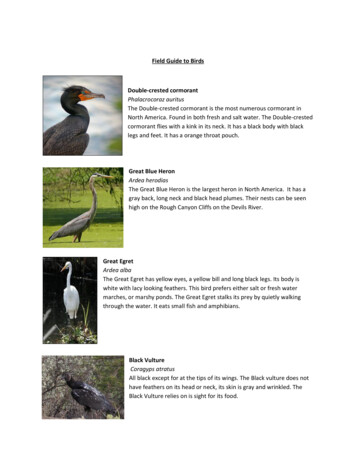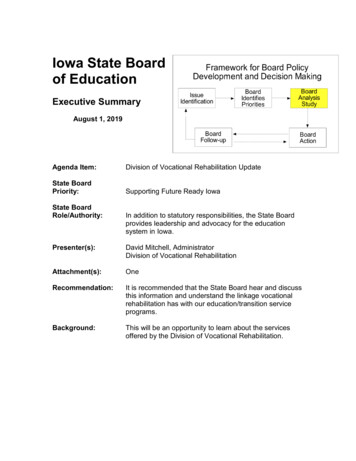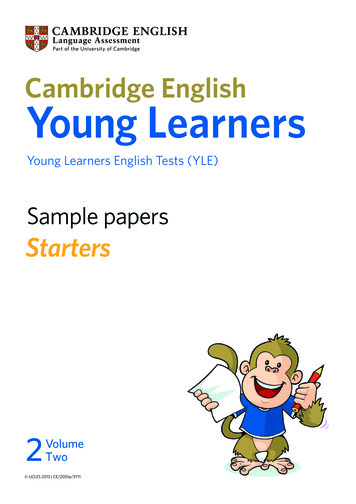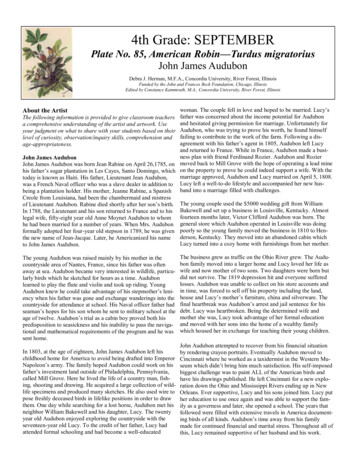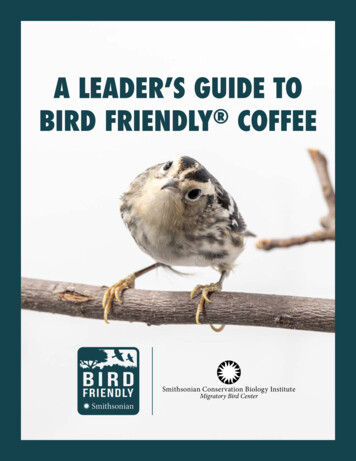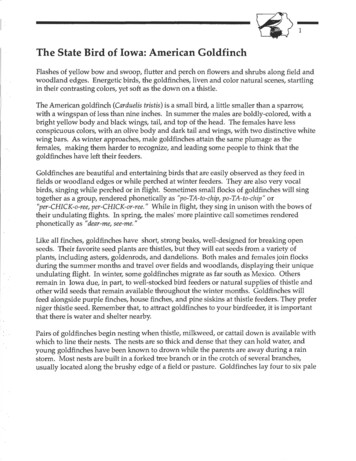
Transcription
II:The State Bird of Iowa: American GoldfinchFlashes of yellow bow and swoop, flutter and perch on flowers and shrubs along field andwoodland edges. Energetic birds, the goldfinches, liven and color natural scenes, startlingin their contrasting colors, yet soft as the down on a thistle.The American goldfinch (Carduelis tristis) is a small bird, a little smaller than a sparrow,with a wingspan of less than nine inches. In summer the males are boldly-colored, with abright yellow body and black wings, tail, and top of the head. The females have lessconspicuous colors, with an olive body and dark tail and wings, with two distinctive whitewing bars. As winter approaches, male goldfinches attain the same plumage as thefemales, making them harder to recognize, and leading some people to think that thegoldfinches have left their feeders.Goldfinches are beautiful and entertaining birds that are easily observed as they feed infields or woodland edges or while perched at winter feeders. They are also very vocalbirds, singing while perched or in flight. Sometimes small flocks of goldfinches will singtogether as a group, rendered phonetically as "po-TA-to-chip, po-TA-to-chip" or"per-CHICK-o-ree, per-CHICK-or-ree." While in flight, they sing in unison with the bows oftheir undulating flights. In spring, the males' more plaintive call sometimes renderedphonetically as "dear-me, see-me. "Like all finches, goldfinches have short, strong beaks, well-designed for breaking openseeds. Their favorite seed plants are thistles, but they will eat seeds from a variety ofplants, including asters, goldenrods, and dandelions. Both males and females join flocksduring the summer months and travel over fields and woodlands, displaying their uniqueundulating flight. In winter, some goldfinches migrate as far south as Mexico. Othersremain in Iowa due, in part, to well-stocked bird feeders or natural supplies of thistle andother wild seeds that remain available throughout the winter months. Goldfinches willfeed alongside purple finches, house finches, and pine siskins at thistle feeders. They preferniger thistle seed. Remember that, to attract goldfinches to your birdfeeder, it is importantthat there is water and shelter nearby.Pairs of goldfinches begin nesting when thistle, milkweed, or cattail down is available withwhich to line their nests. The nests are so thick and dense that they can hold water, andyoung goldfinches have been known to drown while the parents are away during a rainstorm. Most nests are built in a forked tree branch or in the crotch of several branches,usually located along the brushy edge of a field or pasture. Goldfinches lay four to six pale
--2 ---------------------blue eggs, each about 5 I 8 inch in diameter.Goldfinches are popular birds, and there has been some concern that their population maybe declining. In fact, some studies have indicated a possible decline in the number ofgoldfinches in Iowa. Whether this reflects a natural fluctuation in the goldfinch populationor a real and dangerous decline in the number of goldfinches is not clear. The goldfinch'shabitat, which must contain a mixture of grassland and shrub plants, seems to be adequateamong Iowa's farms, pastures, and woodland borders. Future bird surveys and studiesmay help us learn more about any possible threats to goldfinch populations in Iowa.The lively, colorful goldfinch is a common bird of open fields, woodland edges, andbackyard gardens. It is a very charismatic bird, well-suited to the character of Iowa. TheAmerican goldfinch was officially designated the State Bird of Iowa on May 22, 1933. Atthe time it was designated, it was known scientifically as Spinus tristis. Most books nowuse the scientific name Carduelis tristis. The goldfinch was nominated to be the State Bird ofIowa by the Iowa Ornithologists' Union, and the proposal passed the legislature because ofthe backing of that group and because the goldfinch is a year-round resident of Iowa thatis easily recognized by Iowans.By Dan CohenBuchanan County Conservation Board
3How the Goldfinch Became Iowa's State BirdIn February 1926, Iowa Ornithologists' Union (IOU) president Walter Rosene noted in aletter to members that Nebraska had recently named a state bird. He wrote that "if eachstate has its state flower, why should we not have a state bird? It would be interesting tohear from all members in regard to this matter, and I would welcome letters offeringsuggestions."Two months later, he wrote that a few suggestions had been received but not enough toreach a consensus. Margo Frankel from Des Moines suggested that the group "choose anall-year-round bird for Iowa- downy woodpecker or chickadee." Althea Sherman ofNational suggested the goldfinch as "a beautiful bird, easily recognized by everyone. It isof common occurrence in most parts of our state throughout the whole year." Rosenesuggested more nominations for discussion at the spring meeting in Atlantic.No further action was taken on this matter until June 1931 when Dr. F.L.R. Roberts, in apresident's letter to the membership, wrote that "there is a popular demand for a state bird,and it is appropriate that we should be active in choosing one." He then appointed acommittee, consisting of two former IOU presidents, Walter Bennett and Walter Rosene, toprepare recommendations to be presented at the next annual meeting.The next spring at the banquet, members prepared a list of birds for consideration. Aftermuch debate, the goldfinch was selected and was unanimously voted as the IOU' s choicefor state bird. It was chosen because it was commonly known and found in the stateyear-round.Former IOU president Arthur Palas was chosen as chair of a committee to present thispetition to the Iowa Legislature in January 1933. Representative J. Wilbur Dole laterrecalled that Mr. Palas approached him during the first week of March to present thismatter. Mr. Palas, it seems, had forgotten his assignment.Several members of the legislature approached Representative Dole and asked why suchbirds as the robin, bluebird, or quail should notbe considered. He stated that other states hadalready selected those and no one pressed thematter further. Others asked why Iowa evenneeded a state bird. He replied that therewere only four other states that did nothave a state bird. This answer seemed tosatisfy their queries.On March 21, 1933, Dole called up theresolution and spoke in favor of itspassage. It passed unanimously by voicevote. He made the only speech in support ofthe resolution; none was made in opposition.Similar action was taken in the Senate.
4Yi)--------The text of the resolution adopted by the Iowa Legislature is as follows:Whereas, the twenty-sixth General Assembly of the state of Iowa, in the year 1897,by concurrent resolution, adopted the wild rose as the state flower of Iowa, the record ofwhich is duly recorded in Senate Journal, pages 1124 and 1164 and in House Journal, page10235; andWhereas, many states have not only adopted certain named flowers as their stateflower but have also adopted certain named birds as their state birds, andWhereas, the Iowa Ornithologists' Union, an association comprising students andthe lovers of birds, residing within our state, at their annual meeting held in Des Moines, inMay 1932, by resolution and vote designated the Eastern Goldfinch as their choice for astate bird and recommended that said Eastern Goldfinch be adopted as the official statebird of Iowa, thereforeBe it resolved by the House of Representatives, the Senate concurring, that theEastern Goldfinch, Spinus tristis tristis, is hereby designated and shall hereafter be officiallyknown as the state bird of Iowa.A revealing glimpse of how our perceptions of birds have changed can be seen by readingthe byline and story in the March 27, 1933 Des Moines Register article about Iowa's newstate bird. It read, "Goldfinch, Iowa's Official Bird, Is an Aid to Farmer." Further into thestory, it stated that "the goldfinch is valuable to farmers because of the great quantity ofweed seed they consume during a season and the war they wage upon cankerworms, plantlice, small grasshoppers, and beetles." How many people view goldfinches, or birds ingeneral, in this manner now?Much of the information for this article came from a booklet entitled "The Goldfinch: Official IowaBird," written by Josephine Baumgarter and Mabel Goshorn Thte, the editors of the Des MoinesAudubon Society's newslette and published on May 29, 1945. J. Wilbur Dole's account of theevents is included in a letter to the editors of the newsletter.
5Activity: State Bird SearchObjective: Students will identify the state birds of the 50 states in the United States.Materials: Worksheets, pencils, map of the United States, and encyclopediasProcedure: Hand out worksheets and pencils. Have the students useencyclopedias to identify the state bird of each state. On the map of the UnitedStates, paste a picture of the state bird on that state. Discuss why this bird mighthave been kansasNew HampshireCaliforniaNew JerseyColoradoNew MexicoConnecticutNew YorkDelawareNorth CarolinaFloridaNorth PennsylvaniaIndianaRhode IslandIowaSouth CarolinaKansasSouth DakotaKentuckyTennesseeLouisianaTexas higanWashingtonMinnesotaWest VirginiaMississippiWisconsinMissouriWyoming
6 --------Key to Worksheet: The state birds of the 50 states of the United StatesAlabamaNorthern flickerMontanaWestern meadowlarkAlaskaPtarmiganNebraskaWestern meadowlarkArizonaCactus wrenNevadaMountain bluebirdArkansasNorthern mockingbirdNew HampshirePurple finchCaliforniaCalifornia quailNew JerseyAmerican goldfinchColoradoLark buntingNew MexicoRoadrunnerConnecticutAmerican robinNew YorkEastern bluebirdDelawareBlue henNorth CarolinaNorthern cardinalFloridaNorthern mockingbirdNorth DakotaWestern meadowlarkGeorgiaBrown thrasherOhioNorthern cardinalHawaiiNeneOklahomaScissor-tailed flycatcherIdahoMountain bluebirdOregonWestern meadowlarkIllinoisNorthern cardinalPennsylvaniaRuffed grouseIndianaNorthern cardinalRhode IslandRhode Island redIowaAmerican goldfinchSouth CarolinaCarolina wrenKansasWestern meadowlarkSouth DakotaRing-necked pheasantKentuckyNorthern cardinalTennesseeNorthern mockingbirdLouisianaBrown pelicanTexasNorthern mockingbirdMaineBlack-capped chickadeeUtahCalifornia gullMarylandBaltimore orioleVermontHermit thrushMassachusetts Black-capped chickadeeVirginiaNorthern cardinalMichiganAmerican robinWashingtonAmerican goldfinchMinnesotaCommon loonWest VirginiaNorthern cardinalMississippiNorthern mockingbirdWisconsinAmerican robinMissouriEastern bluebirdWyomingWestern meadowlark
The goldfinch was nominated to be the State Bird of Iowa by the Iowa Ornithologists' Union, and the proposal passed the legislature because of the backing of that group and because the goldfinch is a year-round resident of Iowa that is easily recognized b

